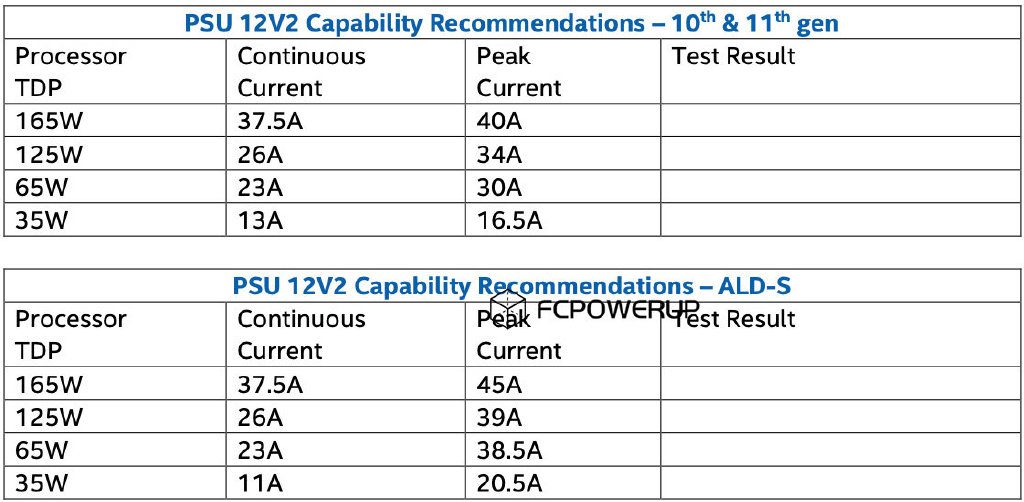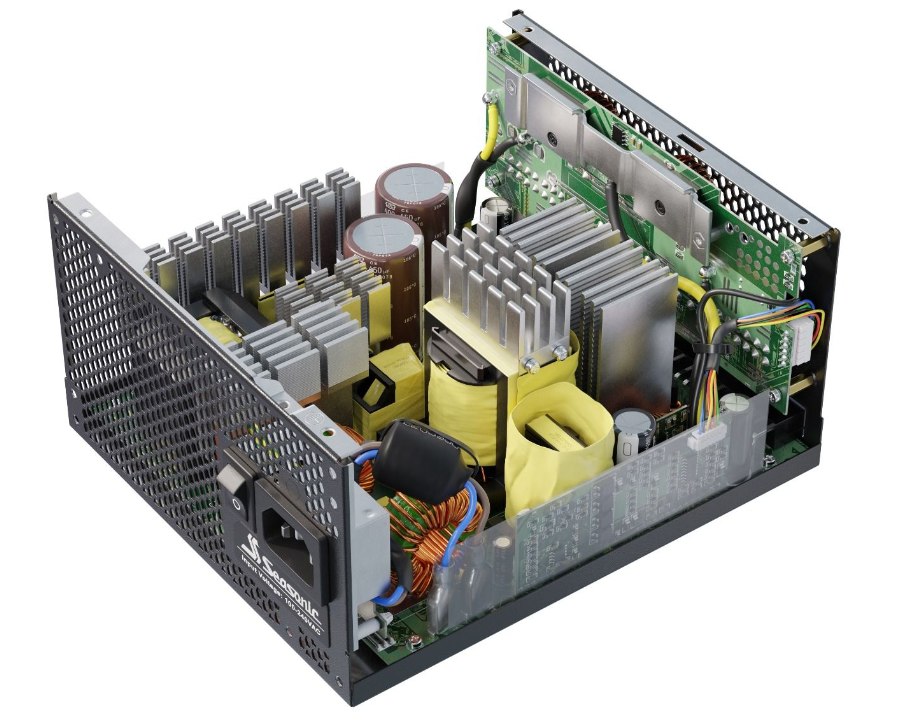Leaked tables show Intel's power supply recommendations for Alder Lake processors
Intel will release new Alder Lake desktop processors in three months—with a powerful new architecture and hybrid big.LITTLE approach for the first time. These CPUs, finally manufactured on 7nm process (originally 10nm Enhanced SuperFin), should have significantly better energy efficiency. But it looks thir power needs will go up despite this. Intel is increasing the currents required from PSUs, which could mean higher power draws.
Or at least, this is what a piece of documentation from Intel that has emerged at Chinese Weibo claims. It bears a style consistent with leaked internal Intel documents, and I would be inclined to say that it is real, because it doesn’t look like the sort of sorts of tables or information that somebody making up fake news would come up with.
So, what is it all about? The leaked table allegedly from Intel lists values of current loads that the power supply should ideally be able support. Therefore they are not a requirements, but rather recommendations. The first table is for processors on the LGA 1200 platform, the second table below is for the LGA 1700 platform, namely Alder Lake. These are current values in amperes that the 12V rail of the power supply supplying the processor should provide (i.e. via an 8-pin EPS connector, or more of these connectors). The first column is the value by Intel that the power supply should handle permanently if needed. The second column indicates how high a spike above these permanent values the power supply should handle, i.e. the peak, short-term fluctuations (and again, these are recommendations).
These are current values at 12V. So, when it is recommended for a processor with 125W TDP that the power supply be able to supply up to 26 A continuously on the 12V rail, that makes 312 W power draw. That’s more than is allowed by the official PL2 251W boost limit, but this number already includes losses happening in the onboard power delivery design on top of the CPU’s PL2 Power Draw. And when we recently tested how much power the Core i9-11900K will draw during x265 encoding using the AVX-512 instruction set, we indeed measured an average of 292 W on the 12V rail with a peak over 300 W. (The motherboard most probably ignored the recommended PL2 limit.)
To give you an idea, this “permanent load” that Intel recommends that the power supplies should handle corresponds to 276 W for 65W processors and to 156 W for 35W models.

The second set of peak values is probably meant as upper, safe limits. For Rocket Lake and Comet Lake, Intel recommends peak currents of up to 34 A (125W processors), which already gives a maximum instantaneous power consumption of 408 W, for 65W models it’s then 30 A (power consumption of 360 W) and for the 35W low-power models it’s 16.5 A (power consumption of 198 W). No reviews have so far encountered such excessive power consumption levels, so it really is probably just a safety headroom to accomodate power draw fluctuations. It can probably be described that the power supplies should be guaranteed to handle these values, while the CPU in turn should not actually achieve them.
The time length that such a peak can last is very short. It should correspond to the time for which the processor can run within the so-called PL4 limit (which is even higher than the better-known PL2, which officially allowed for 56 seconds, unless the motherboard forces it indefinitely). The default time limit for PL4 in Intel specifications is 10 ms, so these power draw spikes should not last longer than that.
Alder Lake will require a larger power upper limit
And now, finally, on how is all this going to change in Alder Lake. The good news is that Intel did not change those recommended stable/permanent values for any of the TDP classes. However, Alder Lake has new and raised recommended upper limits for the short-term load spikes. For 125W models, the recommendation will increase to 39 A, which makes it up to 468 W. But beware, almost the same value will be recommended for 65W models—38.5 A, i.e. 462 W. T-series models with 35W TDP in the Alder generation Lake/on LGA 1700 will have recommended 20.5 A—246 W (the upper limit of this category went up a lot, but only at peak times, the permanent load was reduced conversely, although it still remains very high due to the 35W TDP processors).
| Processor TDP class | Permanent load (at PL2 boost) |
10ms peak (OCP limit?) |
| 165 W | 450 W | 480 W |
| 125 W | 312 W | 408 W |
| 65 W | 276 W | 360 W |
| 35 W | 156 W | 198 W |
| Processor TDP class |
Permanent load (at PL2 boost) |
10ms peak (OCP limit?) |
| 165 W | 450 W | 540 W |
| 125 W | 312 W | 468 W |
| 65 W | 276 W | 462 W |
| 35 W | 132 W | 246 W |
Please, note again that the numbers in the last column are unlikely to really be drawn by the processor. Even if this maximum allowed power is drawn, it will be for a short duration somewhere around 10 milliseconds. For example, the instantaneous power draw of the CPU will fluctuate somewhere from 100 W to 440 W at peak times, but this will average to a draw of only 200 W. This is how the power consumption of graphics cards behaves too and that is why you need to somewhat overprovision your power supply and why, for example, there were initially problems reported with GeForce RTX 3080/3090 when paired with seemingly sufficient power supplies.
Leaks to this date have shown that the typical boost power consumption of Alder Lake processors will remain quite high when all cores are loaded, but at the same time still a little lower than with the 14nm desktop CPUs. According to the alleged specifications of 125W models of the K-series which appeared on the Internet, the PL2 limit will be only 228 W instead of the current 251 W. Therefore, as long as the motherboard does not uncap the limits, the maximum all-core CPU power draw will be 228 W tops and therefore lower than with the 14nm desktop Comet Lake and Rocket Lake processors.

So, the question is why is Intel recommending enhanced power supplies. This could be because Alder Lake may have lower average power consumption, but it may at the same time generate larger fluctuations when loaded (e.g. it might fluctuate between 100–400 W instead of 150–300 W). Allowing higher current peaks in PL4 for those short intervals could possibly allow a faster response to instantaneous loading and allow faster switching of clock speed from low idle to high boost levels, to improve system responsiveness.
Another possible explanation is that these increased current values are not recommended just with respect to Alder Lake processors, but with respect to future generations. Those are said to have more cores, so the PL2 limit could grow again.
Then there is also the possibility that the current values that the power supplies should ideally provide are rising simply because it is a new platform and the specifications of the current that the motherboards/PSUs must supply always tend to go up over time…

Will Alder Lake require stronger power supply?
These reported ampere and watt values sound pretty horrific, but we don’t expect any nasty shocks to come when Alder Lake is released. As already mentioned, all these values are recommendations and not hard requirements, so we hope that in fact it will work with weaker specs as well.
It is possible that, at least in theory, you may need a stronger power supply for Alder Lake if you want to have everything absolutely ideal and with a large reserve. In practice, it should be enough to stick to what is written in the first column. After all, only constant current values are normally reported in the specifications of power supplies, and they should surely handle higher short-term peak than what they are specced for when continuously loaded. Therefore, it is probably appropriate to only use those constant values as guidelines. The peak value in the second column likely says how high the power supply should have its Over-Current Protection set on the 12V rail so that the processor does not exceed this threshold even in the worst case scenario.
Although, looking at my power supply (Be Quiet! Straight Power 10 400 W) makes me think that even the constant values in the first column are not that low. Said unit provides only 18 A on the 12V rail for the processor, so according to this, it would not be recommended for use even with the 65W Intel Comet Lake/Rocket Lake processors. My more powerful 650W MSI MPG A650GF already handles out, 25 A on the CPU rail, which is already in line with the recommendations for 65W processors, but not yet quite enough for 125W Alder Lake processors (but after connecting a second EPS cable from the second or third 12V rail, which are otherwise intended for GPU, it would meet the recommendations).
Things will probably not be so rough in practice, Alder Lake should still run fine, even with its 228W power consumption, with (now quite common) 500–600W power supplies. But this demonstrates that current motherboards using more than one 8-pin connector for CPU supply is not something just for show. For CPUs with similarly high power consumption levels, it is probably also ideal to have a power supply with one unified 12V rail instead of more stand-alone ones, because then you do not have to deal with exceeding the capacity of one of those sub-rails.
Alder Lake processors with 165W TDP?
Additionally, you may notice something else in the table. Namely, that in addition to the 35W, 65W and 125W TDP, 165W TDP is also mentioned as an option. Maybe there are to be some special high performance versions of Alder Lake processors with such an increased TDP value (and perhaps also a higher PL2 than 228 W)? This cannot be ruled out, but the same 165W TDP category is also listed for Comet Lake and Rocket Lake processors, if you take a look. And as we know such TDP is not used in that CPU generation. So maybe this is something that Intel keeps in reserve, and such Alder Lake CPUs may not actually be sold.
Motherboards can get more expensive due to the higher power requirements
If Alder Lake really has slightly higher demands on those peak short-term currents (even though the stable ones are the same), it could lead to more expensive motherboards. VRM and other aspects of processor power delivery will need to be sufficiently provisioned for slightly higher current limits, so there will need to be a more copper in the/more traces in the PCB, the may need to use capacitors of more combined capacity, the motherboards may use more VRM phases on average. After all, the first leaked motherboard has 20 of them.
But if that happens, Intel may not be alone in raising the prices of motherboards. For AMD AM5 motherboards, 170W TDP may newly be supported, which could also force higher currents in the specifications that the power supply should or must handle.
Source: HXL/Twitter, Weibo
Translated, original text by:
Jan Olšan, editor for Cnews.cz








